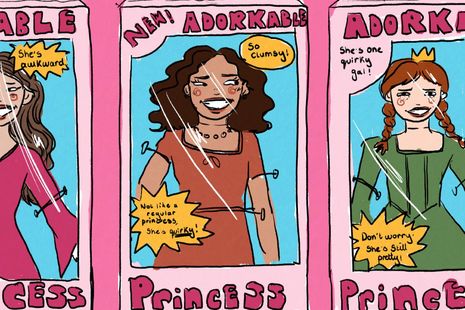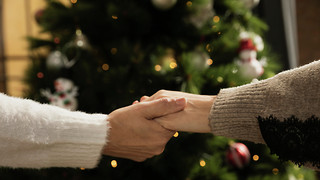Musings on the ‘adorkable’ epidemic
Gina Stock argues that the ‘adorkable’ princess archetype is just another instance of the film industry typifying women

Disney is always caught up in some internet problematisation of character tropes. Most recently, we’ve seen the rise of the “adorkable” female lead in animated movies. There are a number of brilliant video essays and blog posts on this trope and the capitalist motivations behind it. This article simply shares some musings on how this trope interacts with the patriarchy and modern-day brands of feminism.
The “adorkable” character is supposedly a significant transformation, moving away from the passive “damsel in distress” archetype of older Disney animations – which is a welcome change. Instead, after the huge success of films like Tangled and Frozen (and more recently, Encanto), Disney seems to be reproducing a new female archetype – the “adorkable” heroine – who is quirky and socially awkward in a manner that seemingly defies patriarchal expectations. Female characters are “adorkable” if they are “dorky” in a way that is relatable and often conventionally attractive. They’re just awkward enough to still be considered cute and their stubborn independence is their hamartia.
“Children are watching women with an ignorance of social cues be guided by their male counterparts”
In a struggle to react to criticism about binary female characters, from subservient Snow White and Cinderella to the “girlboss” Mulan and Pocahontas, Disney has created a new “type” of woman in their animated films since 2011. Mulan and Pocahontas exemplify the “strong female lead” archetype, where quasi-masculine traits are fitted neatly within a feminine body in what amounts to a fetishisation of dominant women. Mulan quite literally takes on a masculine presence while also sometimes retaining feminine grace. This trope has also come under fire, with critics rightfully pointing out that assigning women masculine traits so they can be called “strong” is a lazy shortcut to creating complex and interesting characters. Disney has therefore had to find a new way to commodify feminism: the “adorkable” woman.
Anna, Rapunzel, Mirabel, Moana and, most recently, Asha from Disney’s Wish all embody a type of patriarchal non-conformity characterised by a somewhat cringeworthy ignorance of societal expectations surrounding politeness and composure. Obviously, all these characters have different plotlines, while Anna and Rapunzel’s awkwardness can be explained by their sheltered upbringings. This awkwardness supposedly makes them relatable and mirrors a modern audience, who have arguably also lost many strict, gender-based behavioural standards.
“Perhaps we should raise a mirror to society to explain the appeal of these characters”
Yet their attractiveness relies heavily on the male gaze. They are cute because they are entirely unaware of their nonconformity. They are lost causes that often need guidance from their male counterparts. This is not only obviously infantilising, but almost a fetishisation of neurodivergent traits, all packaged neatly into a cute and attractive “dork”. These films are primarily marketed at children – children are watching women with an ignorance of social cues be guided by their male counterparts, who in turn help them complete their storyline.
Furthermore, the “adorkable” heroine appears staunchly independent. Yet this independence is always presented in an extremely controlled way, ensuring that it doesn’t compromise her “cuteness.” It’s often her prescribed only “flaw”: Anna needs Kristoff, Moana needs Maui, Rapunzel needs Flynn, to guide them with knowledge they don’t have.
After the huge success of Tangled and Frozen, Disney has found another formulaic female archetype that offers a shortcut to writing popular and relatable characters. However, Disney has obviously only responded to commercial success. Perhaps we should raise a mirror to society to explain the appeal of these characters, as feminism has rightfully shunned the one-dimensional passive woman and, more recently, the one-dimensional “strong” woman. Nevertheless, films still gravitate towards a form of female independence that is quirky, endearing and ultimately non-threatening for male domination.
Fundamentally, the “adorkable” Disney heroine is just another example of the film industry’s marvellous ability to typify women and limit their character nuance. The most recent version of this type, Asha, was not so popular and an underwhelming addition. Thus, we are left to wonder what type of woman screenwriters who struggle to keep up with feminist criticism will roll out next.
 News / Cambridge students accused of ‘gleeful’ racist hate crime4 December 2025
News / Cambridge students accused of ‘gleeful’ racist hate crime4 December 2025 News / Uni redundancy consultation ‘falls short of legal duties’, unions say6 December 2025
News / Uni redundancy consultation ‘falls short of legal duties’, unions say6 December 2025 News / Churchill announces June Event in place of May Ball3 December 2025
News / Churchill announces June Event in place of May Ball3 December 2025 News / Cambridge cosies up to Reform UK30 November 2025
News / Cambridge cosies up to Reform UK30 November 2025 Comment / Don’t get lost in the Bermuda Triangle of job hunting 24 November 2025
Comment / Don’t get lost in the Bermuda Triangle of job hunting 24 November 2025










